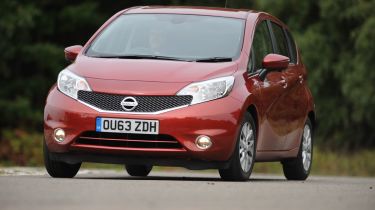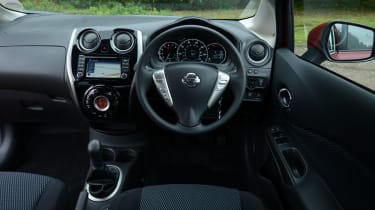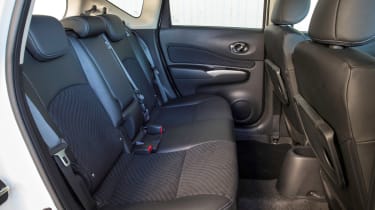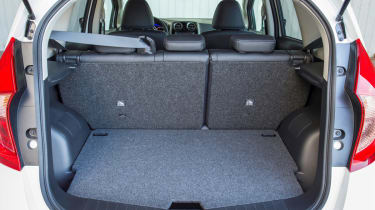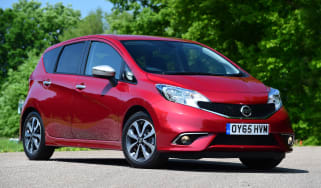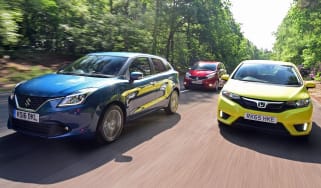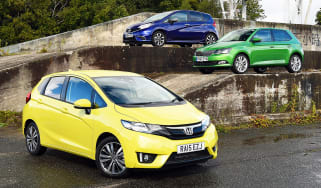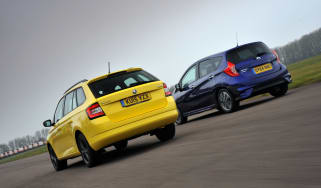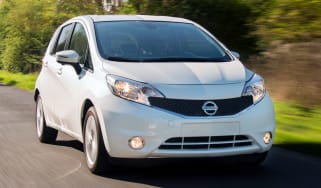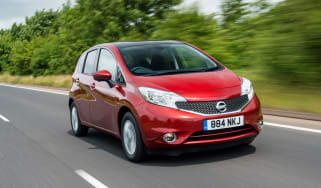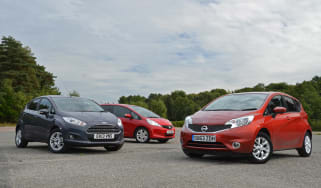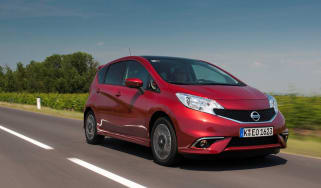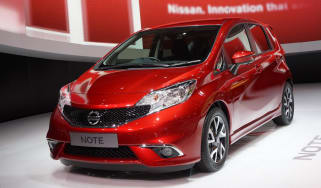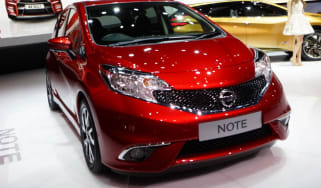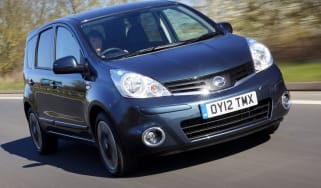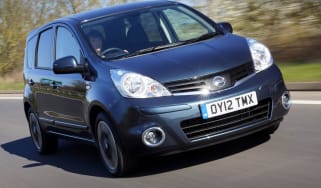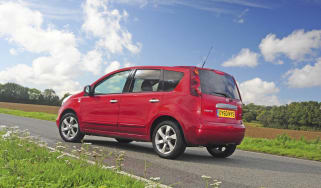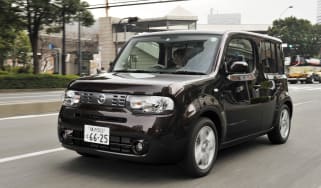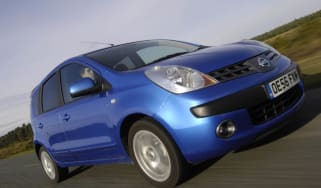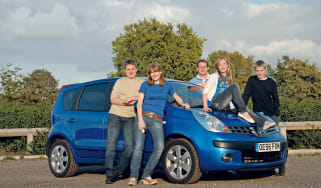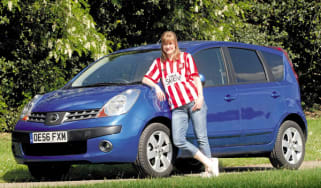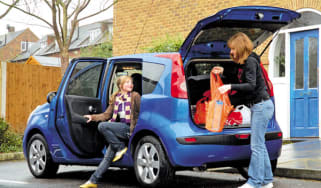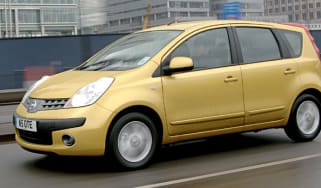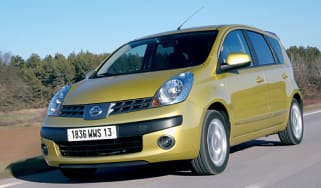Nissan Note (2013-2017) review
Nissan's hugely practical small car is packed with technology: it's also stylish and decent to drive

The Nissan Note is a modern-looking, well-built small car that’s a little larger than a conventional supermini but the benefits of this come in the exceptional space efficiency and flexibility of its well planned interior. It’s a match for many larger family hatchbacks for passenger space and luggage space, making it a front-runner for those seeking maximum practicality for the money.
It has other attributes too, though. The engine range is small but all the motors are modern and very fuel efficient, while the DIG-S 98 petrol and dCi 90 diesel both pull well in combination with that excellent fuel economy.
Another Note positive is its high-tech infotainment system, which includes sat nav, clever apps and even internet radio. The fact it’s included in the list price of many models is a real bonus – and almost makes up for the Note’s slightly drab interior and cheap-feeling interior plastics.
Overall, the Note offers great value for money and tremendous practicality that means the British-built car should be on the shortlist of anyone seeking maximum space and value for money.
The Nissan Note appeared on the UK market as a rival for the Honda Jazz in 2005, though a second-generation model – the car currently on sale – made its debut in 2013. It went off sale in 2017, when the all-new Nissan Micra arrived. While the Jazz is the most obvious longstanding rival, it’s priced to compete with popular superminis such as the Ford Fiesta, Vauxhall Corsa and Volkswagen Polo too. Nissan is targeting car buyers after supermini size and value, but with added headroom and practicality – hence the mini MPV shape. Other rivals include the Vauxhall Meriva and Citroen C3 Picasso.
For a while, the British-built Note was the most appealing small car in the Nissan range. However, with the arrival of the new Micra – a larger, more spacious offering than its predecessor, and the ever-increasing market share of small crossovers, the Note’s days may be numbered.
Popular models such as the Renault Captur, Peugeot 2008, Hyundai ix20 and Kia Venga all count as indirect rivals to the Note – as indeed does Nissan’s strongly-selling Juke, as well as the latest Micra.
This is partly why Nissan has focused on style with the latest Note, particularly in some of the stylish trim lines it now offers, in particular the n-tec. Colours are appealing and you can even get features such as large polished alloy wheels, all helping the Nissan cut a dash on the street.
The range is based around 7 core models: Visia, Acenta, Acenta Style, Acenta Premium, n-tec, Tekna and Tekna Style. There’s also the well-priced entry-level Visia Limited Edition, which offers superb value for money if you don’t mind being restricted by engine and options choice.
Engines, performance and drive
The Nissan Note is based on a well-proven platform used by the Renault-Nissan Alliance: dubbed V-platform, it’s also used by the latest Renault Clio. It’s sold in Japan too, but Nissan has fine-tuned the platform here in Britain for European consumption, which means there’s a marked difference between the two – in our favour.
It’s not as fun to drive as the class-leading Ford Fiesta, of course, but it still handles tidily enough, with good body control for a small car that’s slightly taller than the norm. Body lean in corners is kept under control and we also found the steering was well weighted.
The ride can be a little firm as a result though, particularly over pattery surfaces. But it does improve with more than one person in the car, and the integrity of the suspension means it shakes off rough roads better than you might expect.
Engines
Nissan offers just three engines with the Note, two petrol engines and a single 1.5-litre diesel that’s shared with many other models in the Renault-Nissan Alliance. The entry-level 79bhp 1.2-litre is a three-cylinder unit that performs well enough, with a reasonably torquey nature and smooth, free-revving manners.
The petrol engine you really want is the 1.2 DiG-S, a 97bhp supercharged version of the base three-cylinder motor. Introducing tech normally associated with high-performance Jaguars, the supercharger boosts power and, in particular, torque: instead of producing 110Nm, the high-power DiG-S 98 produces 147Nm, which has a significant effect on in-gear flexibility, cutting back on downshifts.
Naturally, the supercharged 1.2-litre engine is the fastest Note on sale, although it’s perhaps not as fast as its high-tech nature sounds: it does 0-62mph in 11.8 seconds, instead of the regular car’s 13.7 seconds. An Xtronic CVT automatic version of the DiG-S is also available, which does 0-62mph in 12.6 seconds.
The sole diesel engine is the 1.5 dCi 90, an 89bhp version of the familiar Renault-Nissan four-cylinder turbo diesel motor. This has a big hike in torque again, with 200Nm meaning it produces almost twice the pulling power of the base 1.2-litre petrol, at just 1,750rpm instead of 4,000rpm. For this reason, it’s worth going for diesel if you regularly drive a fully-laden Note.
Performance of the diesel isn’t far behind the DiG-S, either: it does 0-62mph in 11.9 seconds and is just 1mph slower all-out with a top speed of 111mph. It’s worth noting that the diesel is a bit clattery and vocal compared to the petrol engines, though.
Manual gearbox choice is restricted to a five-speed unit. It’s snappy enough and the clutch is reasonably light too – both important considerations in city-based cars. The alternative is that automatic Xtronic CVT gearbox, which is a lot less favourable. In common to all CVT units, its single gear nature doesn’t feel natural and, if you drive quickly, the engine will often be revving loudly. Unless you have to, stick with the manual (and enjoy the significant £1,100 saving).
MPG, CO2 and Running Costs
All Nissan Notes are economical, fuel-efficient cars. Even the base 1.2-litre 80 engine averages 60.1mpg – it’s no low-tech alternative, despite its entry-level price. Sub-110g/km CO2 is impressive as well: it’s a good choice if your demands are low.
The better choice is the 1.2 DiG-S 98 engine, though. Not only is this engine faster, torquier and more flexible, it’s also more fuel-efficient – an extremely impressive blend of conflicting attributes. It officially averages 65.7mpg on the combined cycle and also emits just 99g/km CO2, thus pre April 2017 cars dip below the 100g/km road-tax exemption benchmark.
Do note, however, pairing it with the supposedly efficient automatic Xtronic gearbox inflicts a significant fuel economy hit. Combined efficiency drops to just 55.4mpg and CO2 emissions go up four tax bands to 119g/km.
The diesel is naturally the most fuel-efficient choice. It averages an exceptional 80.7mpg and emits just 90g/km CO2 – when you factor in the Note’s space and flexibility, it gives terrific bang for your buck in terms of fuel costs. Do also note, all Nissan Note models come with engine idle stop-start as standard, boosting city centre fuel economy.
While the Note’s Driver Power overall result was a bit disappointing in 2015, it fared much more strongly for running costs, suggesting owners are pleased with its real world performance.
Insurance groups
Insurance groups are generally low for the Note, meaning it should be affordable to insure. All 1.2 80 models apart from the sporty-look n-tec are in group 6; the more stylish n-tec moves up just one group, to 7.
All 1.5 dCi 90 Notes are in group 9, apart from the entry-level Visia; this has a single insurance group advantage, coming in at group 8.
The biggest variance comes with the highest-performance DiG-S 98 model, which has the highest insurance rating of all Note models, at group 10. This is as you may expect – however, there are some positive exceptions. Choose an Acenta Premium or Tekna model with the Safety Comfort option pack and the insurance rating drops two groups, to group 8.
Why is this? Because they include the Safety Shield technologies and Around View monitor as standard. Safety Shield brings blind spot warning, lane departure warning and moving object detection – safety features that insurance assessors clearly think bring a real benefit that will lower the car’s insurance risk.
Depreciation
On average, the Note performs well on the used market, retaining around 42% of its new price. Diesels are a little better still, retaining around 44%. The star of the range is the super-value 1.2 Visia Limited Edition, which backs up its sub-£10,000 list price with a fantastic retained value of 49%.
The Xtronic automatic models seem not to be well liked on the used market and are the only Notes with a retained value of less than 40%. This is most likely due to the significant extra cost of the CVT gearbox and is worth bearing in mind.
To get an accurate valuation on a specific model check out our free car valuation tool...
Interior, design and technology
The Nissan’s very practical interior doesn’t look all that spacious at first glance, due to Nissan’s use of drab colour schemes that make it feel more claustrophobic than it actually is. The fact there are quite a few cheap-feeling, flimsy plastics doesn’t help: actual build quality is pretty good but the choice of materials lets it down.
Nissan does spice it up a little with some aluminium styling trims for the centre console and doorhandles, but it’s not quite enough. Perhaps the fanciest part of the interior are the clear, high-tech looking dials, including a colour-changing econometer that delivers feedback on your driving efficiency in real time.
Otherwise, the interior design of the Nissan Note is nothing to write home about – in contrast to the infotainment technology that’s included as standard with Acenta Premium models and above. This is based around the NissanConnect touchscreen system and packs in a lot of technology for the money that helps the Note stand out alongside many of its rivals.
Our choice Acenta Premium features the NissanConnect as standard, along with climate control, automatic lights and auto wipers. The Comfort pack includes a glass roof and keyless i-Key; this can be combined with the Safety pack, which is well worth specifying.
The best-looking Note of all is the n-tec, which has satin silver door mirrors and handles, aerodynamic front bumper, rear view camera and special blue stitching on the inside: it’s just a pity you can only have the basic 1.2-litre engine with this trim line, rather than the DiG-S or dCi motors.
Sat-nav, stereo and infotainment
The Note fares well here. All models get a four-speaker CD stereo with AUX and USB sockets. Trade up to Acenta Premium and above and the NissanConnect 5.8-inch touchscreen system is standard – this brings DAB and internet radio, plus improved six-speaker sound.
The NissanConnect system also includes standard navigation, which is a strong reason for trading up the range to this model. Factor in the array of infotainment apps and functionality and you have a surprisingly tech-packed car for this sector.
Practicality, comfort and boot space
Practicality is a real strong point of the Nissan Note. As we’ll see, its boot is extremely flexible, while rear-seat passenger space is very flexible if you choose mid-range models and above.
We found the seats a little flat and unsupportive for longer-distance journeys (something Driver Power results agree with – the Note is well below average here), but they’re OK for shorter-journey in-town use – and really wide door openings front and rear make it extremely easy to step in and out of. The rear doors open almost 90 degrees and the extra height off the ground further aids ease of stepping in and out.
The driving position is OK and clear controls make it easy to use. It’s a pity steering reach adjustment isn’t available on any Note variant though: saying that, the driving position is decent enough so its omission isn’t too painful.
It’s worth noting that air-conditioning is only standard on Acenta models and above, not the base Visia. Bluetooth connectivity does, however, feature on all Notes as standard. The Tekna models also get a handy ‘around view’ parking monitor that gives an uncanny ‘bird’s eye’ view around you on the central screen – a really cool yet handy gadget.
Dimensions and size
The Note is a little larger than the supermini norm but, as we’ll see, it puts this to good use. Overall length is 4,100mm long, which stretches a little to 4,135mm if you take the Style pack (that’s because these models have an alternative aerodynamic front bumper design and a carbon-look rear bumper).
The Note is 1,695mm wide, making it a little narrower than many other cars offering this much interior space: city centre dwellers may find this advantageous. It’s a tall small car too, 1,530mm high or 1,535mm if you choose the glass roof option.
Leg room, head room & passenger space
Here is where the Note excels – it’s an extremely spacious supermini-sized car all round, for both front and rear seat passengers. Those in the front sit high, albeit on slightly flat and undernourished seats; the Note feels confident from behind the wheel as a result, with more big-car character than most superminis and supermini MPVs.
The real story is in the rear though. The rear bench seat of all Notes is comfortable and offers loads of headroom and legroom to passengers – but choose an Acenta Premium model or above and you get a full sliding rear bench that transforms the Note’s flexibility and space efficiency.
The boot size alters as you slide the seat back and forth, but the benefit is exceptional rear legroom if luggage space isn’t so important. The Note offers more rear legroom than some large executive cars almost a metre longer in overall length. The seat slides a full 160mm and the flexibility it offers is a real USP for Nissan’s supermini-sized MPV. Big, deep side windows add to the feeling of spaciousness for rear passengers.
The cabin is pretty practical, with a double-decker glovebox and numerous cupholders being the standouts: there are even dual cupholders in the rear seat armrest. It’s a pity the door pockets are so thin though – this is where the Note’s narrower dimensions over larger cars shows through.
Boot space
The Note puts its square, tall dimensions to good use with a practical and user-friendly boot. Because it’s so practical, Nissan lists a number of dimensions for buyers to understand – and the key dimensions are for the ultra-practical sliding rear seat option, fitted to Acenta Premium models and above.
With the seats in their rearmost position, giving rear-seat passengers the maximum legroom, it offers 325 litres of space. Even this is 30 litres larger than a Ford Fiesta – but there’s more. Trade that rear passenger space and slide the seat fully forward, and luggage space extends to 411 litres – and that’s 30 litres larger than a Volkswagen Golf!
With the rear seats folded fully flat, a massive 1,495 litres of luggage space is available, way above what’s normal for a supermini-sized car (and significantly larger than the Nissan Juke crossover). With the seats down, a length of 1.7 metres is opened up. If you choose a ‘T-space-saver’ wheel instead of the puncture repair kit, luggage space drops by 30 litres; worth bearing in mind.
Nissan also has a super Flexiboard solution for the boot: this allows you to tailor the layout to numerous different compartments. You can even split it in two, creating dual load compartments that are ideal for securing fragile items (and it has a waterproof side too, enabling you to split muddy football kits). With the seats fully back and with the Flexiboard in its upper position, 195 litres of boot space is available – still and impressive amount given the all-round practicality.
We also like the fact Nissan’s even included several shopping hooks and a 12v socket in the boot – small additions that show the firm’s attention to detail here.
Reliability and Safety
Buyers generally expect front-running reliability from Japanese cars like Nissans, but Driver Power survey results show the Note can’t quite deliver these high expectations in practice. Reliability is so-so and build quality is very poor compared to Nissan’s usual high standards – the Note was placed 193rd here, out of 201 cars. This weak result is undoubtedly due to the car’s cheap plastics and shiny finish.
The Note was tested by Euro NCAP in 2013 and scored a four-star safety rating – not a full five stars but it is to the safety testing body’s stricter standards. Adult and child protection were strong, with 86% and 82% respectively awarded, while safety assist was also good at 70%. The Note’s weakness was pedestrian protection, where it scored a mediocre 58%.
An alarm isn’t standard on any Note from the factory; it was a £291 option on all variants. Nissan also offers various protection packs that improve the durability of the car in real-world use.
Warranty
The Note is covered by a three-year, 60,000-mile warranty, in line with most cars in this sector. One this is up, a Nissan Care extended warranty is offered, so long as the car hasn’t covered more than 60,000 miles or is older than three years: prices here start from £245.
The Nissan warranty also includes three years’ pan-European roadside assistance.
Servicing
All Nissan Notes, be they petrol or diesel, have 12-month, 12,500-mile service intervals (it’s whichever comes first). Nissan offers a range of optional service plans too, for fixed-price maintenance over a number of years.
